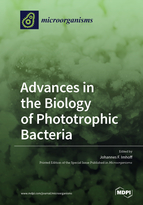Advances in the Biology of Phototrophic Bacteria
A special issue of Microorganisms (ISSN 2076-2607). This special issue belongs to the section "Environmental Microbiology".
Deadline for manuscript submissions: closed (31 March 2021) | Viewed by 55029
Special Issue Editor
Interests: marine microbial diversity; marine biotechnology; marine natural products; phylogeny and taxonomy of anoxygenic phototrophic bacteria; photosynthetic bacteria from extreme environments
Special Issues, Collections and Topics in MDPI journals
Special Issue Information
Dear Colleagues,
Phototrophic bacteria represent a remarkable group of microorganisms which has significantly shaped the earth environment over millennia. During early ages and in the absence of oxygen in the atmosphere, photosynthetic capabilities have developed in several prokaryotic phyla, including Chlorobi, Heliobacteria, Chloroflexi, Chloracidobacteria, and Proteobacteria. With the onset of oxygenic photosynthesis and the release of oxygen into the atmosphere, the conditions for life changed dramatically, and many phototrophic bacteria were pushed back to anoxic environmental niches. On the other hand, oxygen helped to initiate adaptation of some phototrophic bacteria, making them well adapted to live in the anoxic environment to various levels of oxygen. Finally, this has led to dependence on oxygen for a number of anoxygenic photosynthetic bacteria. As a consequence, phototrophic bacteria are found in all kinds of photic environments, including those with extreme conditions for life as hot vents, saturated brines, acid peat bogs, dry rock surfaces or even solid ice. They proliferate under very low as well as under extremely high rates of illumination, in the strict absence of oxygen, and also under the full pressure of atmospheric oxygen.
In this Special Issue of Microorganisms, you are invited to send contributions (original articles as well as reviews) concerning the biology and biodiversity of phototrophic bacteria, in particular using genomic and metagenomic approaches to study microbial communities. Information that will improve our understanding of the evolution of photosynthesis and phototrophic bacteria, of their adaptation to the wide spectrum of environmental conditions, and of their genetic and functional diversity is especially welcome.
Prof. Dr. Johannes F. Imhoff
Guest Editor
Manuscript Submission Information
Manuscripts should be submitted online at www.mdpi.com by registering and logging in to this website. Once you are registered, click here to go to the submission form. Manuscripts can be submitted until the deadline. All submissions that pass pre-check are peer-reviewed. Accepted papers will be published continuously in the journal (as soon as accepted) and will be listed together on the special issue website. Research articles, review articles as well as short communications are invited. For planned papers, a title and short abstract (about 100 words) can be sent to the Editorial Office for announcement on this website.
Submitted manuscripts should not have been published previously, nor be under consideration for publication elsewhere (except conference proceedings papers). All manuscripts are thoroughly refereed through a single-blind peer-review process. A guide for authors and other relevant information for submission of manuscripts is available on the Instructions for Authors page. Microorganisms is an international peer-reviewed open access monthly journal published by MDPI.
Please visit the Instructions for Authors page before submitting a manuscript. The Article Processing Charge (APC) for publication in this open access journal is 2700 CHF (Swiss Francs). Submitted papers should be well formatted and use good English. Authors may use MDPI's English editing service prior to publication or during author revisions.
Keywords
- Bacterial photosynthesis
- Phototrophic bacteria
- Anoxygenic photosynthesis
- Anaerobic/aerobic phototrophic way of life
- Phylogeny
- Evolution
- Genetic/functional biodiversity
- Environmental gradients
- Thermophilic
- Halophilic







